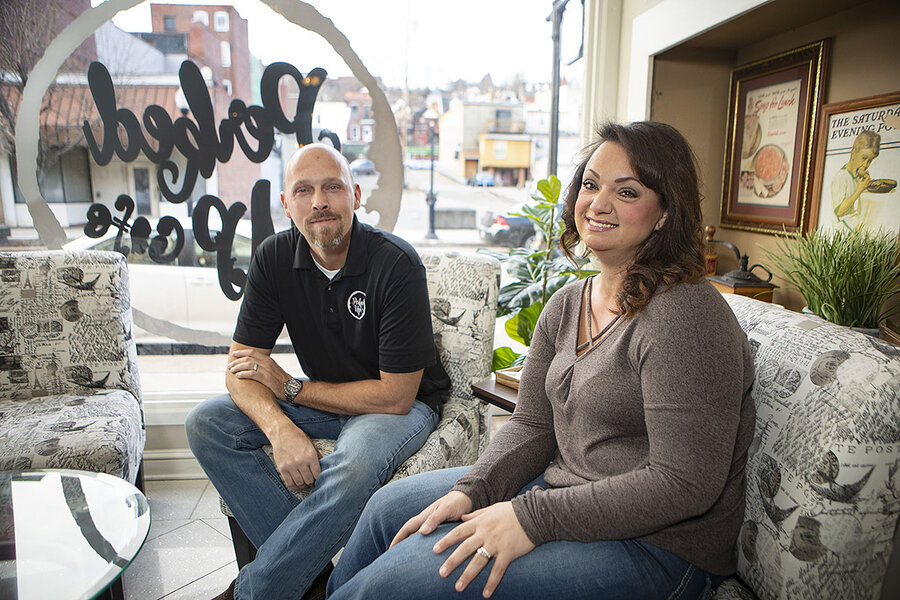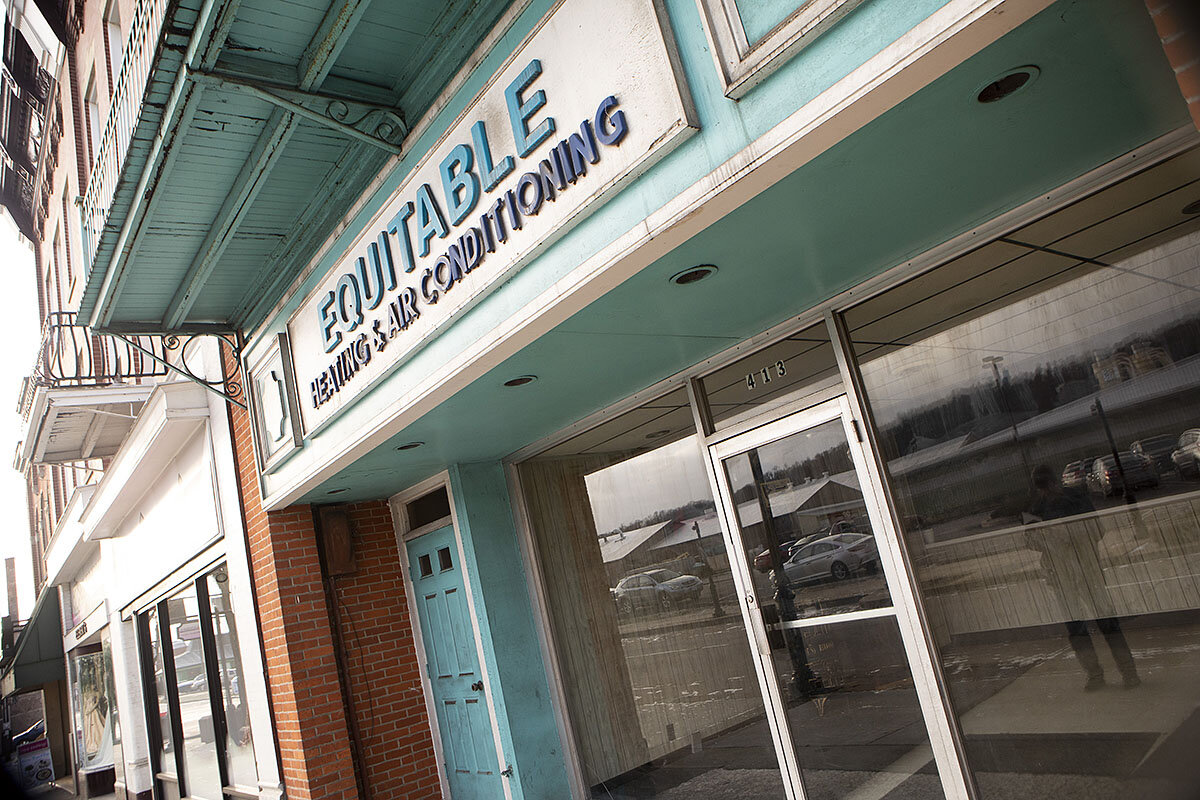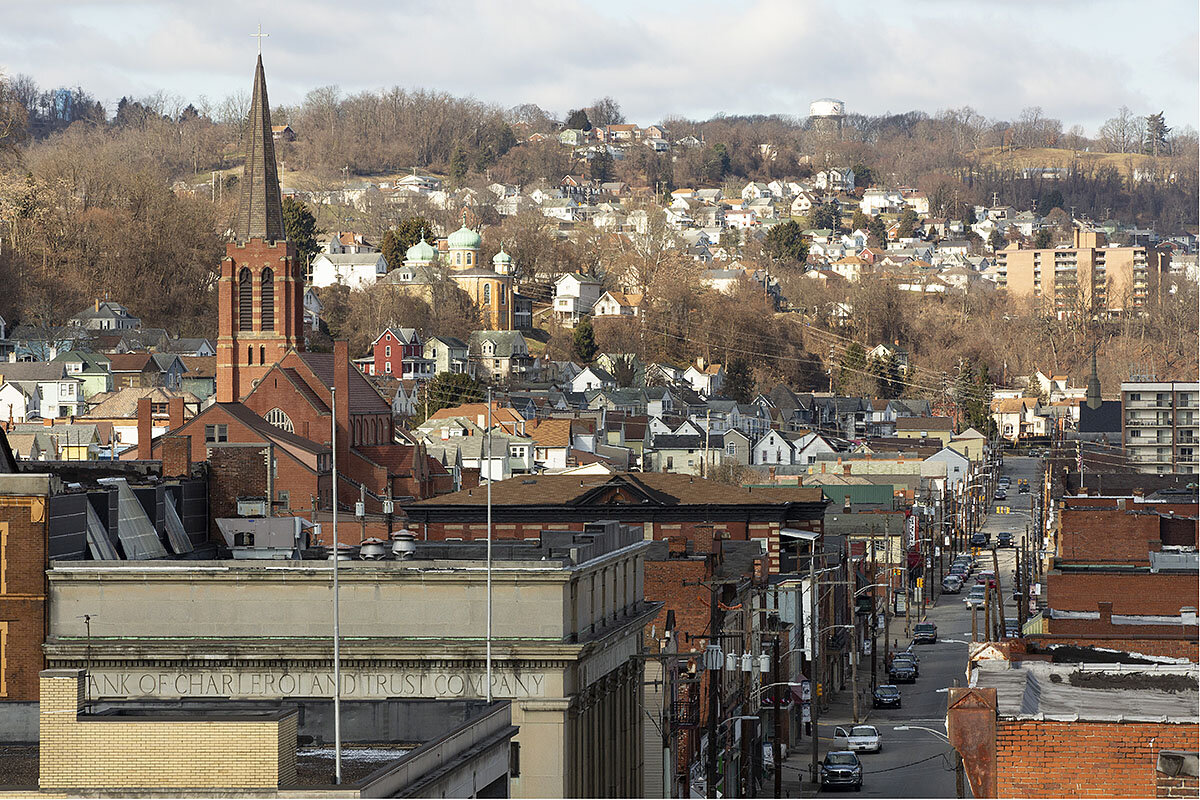In steel country’s river towns, a rising spirit of recovery
Loading...
| CHARLEROI, Pa.
Cruising down McKean Avenue, a main drag of this blue-collar river town in southwestern Pennsylvania, Charleroi presents two faces.
One is Equitable Heating and Air Conditioning, decked out in a white and powder-blue motif from a bygone era of prosperity, which now stands vacant, like many storefronts in town.
The other is the Perked Up Cafe, a three-year-old venture that draws couples and families and the local movers and shakers, who bump into each other while ordering the restaurant’s special blend of coffee.
Why We Wrote This
How can small towns recover from widespread economic downturns? New industries help, but so do intangibles like charm, faith, and spirit – in ample supply, our reporter found, in the mid Mon Valley.
Which one represents the future of Charleroi (pronounced SHARL-uh-roy) and the other communities here along the Monongahela River, which locals call the mid Mon Valley? It depends on how you look.
“The bricks-and-mortar have continued to deteriorate; there are a lot of ifs,” says Jamie Protin, an economic development consultant and tireless area promoter. “But the spirit of the people, the enthusiasm and the hope and the faith and all of those things, are starting to come together. ... I have really seen a dramatic shift in the mindset of the people.”
Onetime boomtowns, the cities and towns (called boroughs here) all along the Monongahela have been declining for 70 years or more. The biggest shock came in the 1980s, especially downriver in the lower Mon Valley, closer to Pittsburgh, when the steel industry withered to a shell of its former self and plants closed one after the other.
Even here in places like Charleroi, decline came like a giant vacuum, sucking the vitality out of the river towns. Pittsburgh and other communities that could make the switch to high-tech and services recovered and prospered. New bedroom communities sprang up like patchwork in the surrounding hills.
But in the Mon Valley itself, a turnaround still seems elusive.
Yet two factors are spurring hope. A boom in natural gas fracking in the two counties south of Pittsburgh, and a gas-to-plastics processing plant under construction north of the city, could create a spate of plastics industries in the area. The other trend is that entrepreneurs are discovering the river towns.
“There’s so much charm in towns like this,” says Casey Clark, who owns the Perked Up Cafe with her husband, Eric.
Working at a manufacturing plant in nearby Donora, they bought a building in downtown Charleroi for an art studio in 2014. Three years later, when the vacant building next door came up for sale, they bought it and turned it into a coffee shop.
“Business is good,” says Eric Clark. “We are just going straight up.”
A few other places have opened up in town in recent years – a Chinese restaurant and a tattoo parlor. Corelle Brands, which makes the famous Pyrex glassware in Charleroi, last year began a $16 million upgrade of its plant intended to keep its 350 workers employed for years to come. An expressway project is improving access to the river communities. And local industrial parks have attracted new businesses.
“Manufacturing is getting to be an area that we can move forward on,” says Diana Irey-Vaughan, a commissioner of Washington County. “It’s everything from equipment suppliers to plastics.”
Yet, even the optimists concede the area has a long way to go.
“Some people still have in their minds the ’60s, when the steel mills employed 1,500” workers apiece, says Mark Alterici, who owns Dee’s Wireless, a regional chain of cellphone stores, which is the latest incarnation of the TV store his father used to run. “My dad’s motto was: always something new,” he adds.
Memories of what was have made it difficult for the region to move forward. When Michael Coury and his wife moved to Charleroi from Pittsburgh 17 years ago and proposed opening a local pizza shop, “people told me I was crazy, even the other local businessmen,” recalls Mr. Coury. But the first night the couple opened, the place was packed, he recalls.
Four years later, the couple moved a half block away and opened the River House Cafe, a favorite for people from around the region.
“This is a great town for a young entrepreneur: cheap rents, cheap real estate,” says Mr. Coury. “There’s a lot of money in these small towns.”
Tony Bottino, an insurance agent and president of the Monongahela Area Chamber of Commerce, is also upbeat. “We are so used to being so pessimistic,” he says, “I actually think we’re in a good position to plan for growth.”
In some ways Monongahela, some 10 miles downriver of Charleroi, might serve as a model for other river communities. It never had a large industrial mill, so it has always worked on developing its retail sector and tourism.
“Ten years ago, it was 40%, 50% vacancies” in the business district,” Mr. Bottino recalls. “Now, it’s hard to find a place on Main Street that’s usable.”
Daunting challenges remain. While cheap real estate helps entrepreneurs, it results in a small tax base that makes it hard for schools to fund programs and attract top teachers. U.S. News & World Report last year ranked Charleroi High School among the bottom third of Pittsburgh-area high schools.
But “our community support is second to none,” says Edward Zelich, superintendent of the local school district.
Every year, the Charleroi Area School District raises approximately $30,000 for its volunteer food program. On Fridays, elementary and middle school teachers pack 175 bags of food so needy local students will have enough to eat over the weekend.
Another challenge is the housing itself, which doesn’t lend itself to attracting professionals. The biggest obstacle may be the parochialism that infuses the region. Residents’ loyalty to their communities, which is a strength for local activity, makes it hard to craft a regional strategy.
Instead, large companies – even nonprofit hospitals – have to work with a sometimes bewildering array of officials and geographical entities.
To get things done, “I cross party lines, district lines, county lines,” says Louis Panza, CEO of the Monongahela Valley Hospital, an economic mainstay of the area that employs 1,350 people. Then there’s the river itself, which creates still more geographical divides.
There’s no agreement on whether river development should be primarily industrial, residential, or tourism-based.
Mr. Protin drives down to the Monongahela Aquatorium, a 3,700-seat outdoor stage where bands and singers perform right on the river during the summer.
“I think we could be the next growth area: river, rails, history,” he says. “Charleroi will never ever be what it once was. It can be something different.”
It’s an attitude, says Ms. Clark, back at the Perked Up Cafe. She holds her hand horizontal in the air. “It’s a hard line. Either you are up here or you are down there.”










